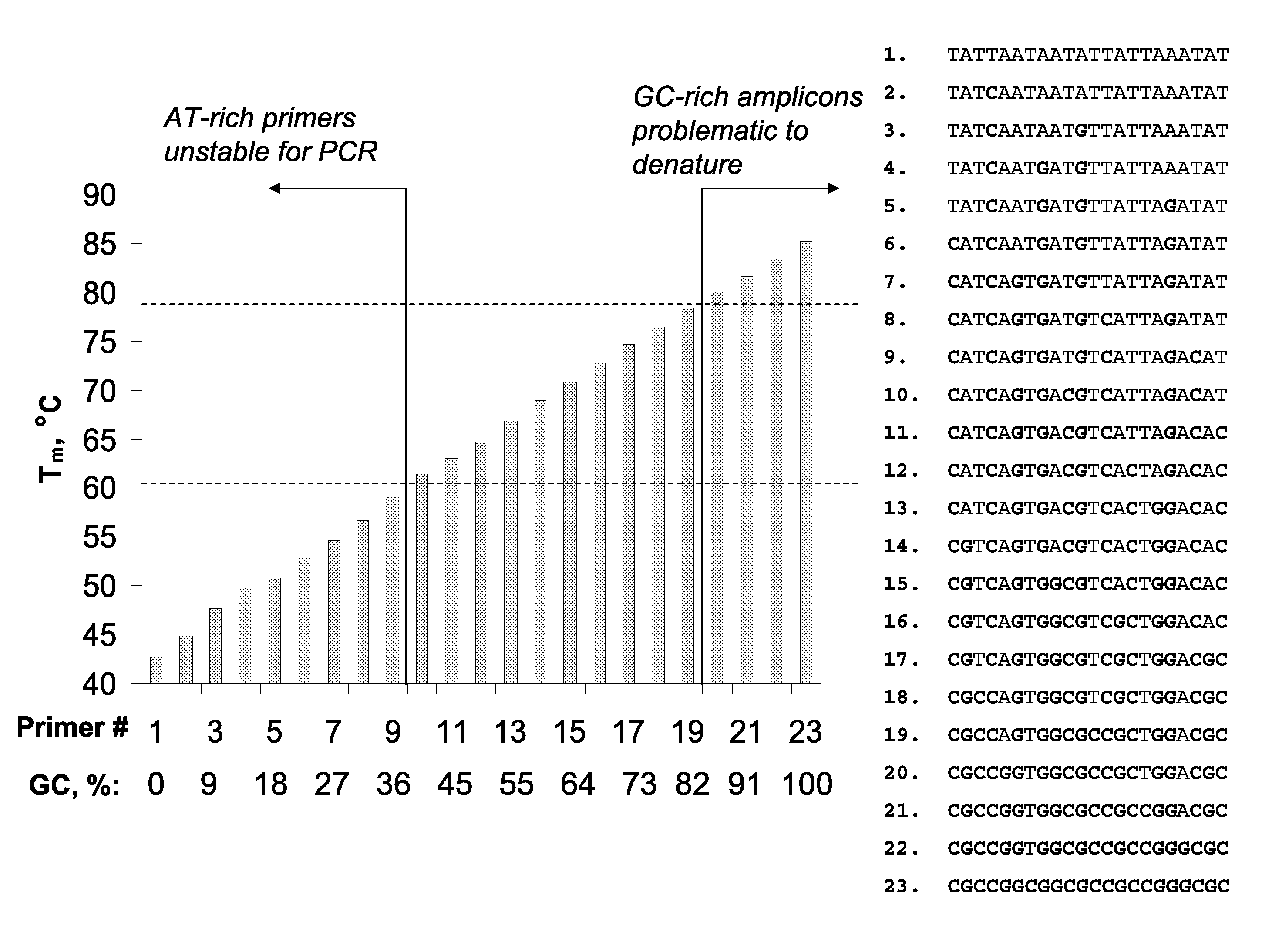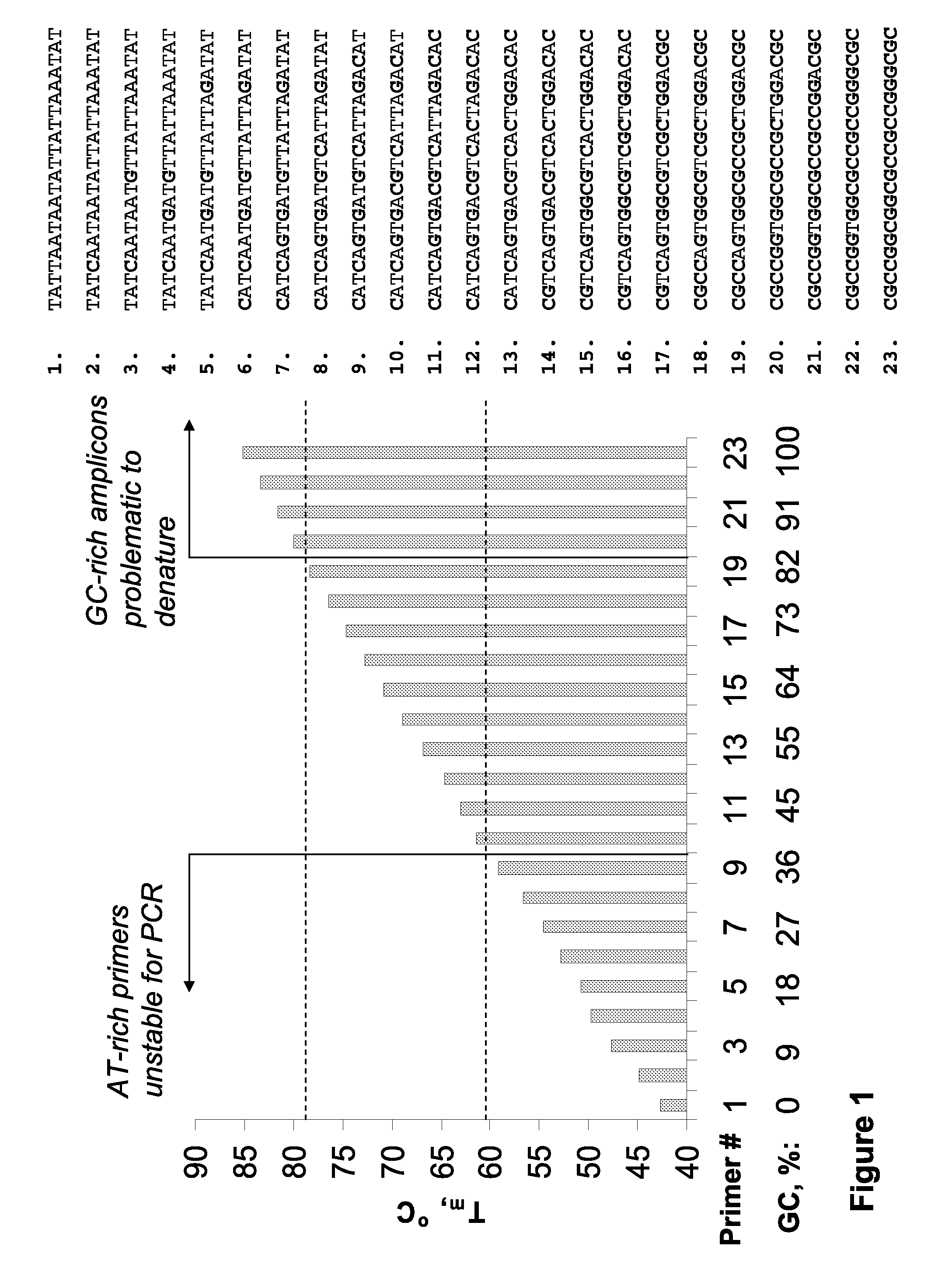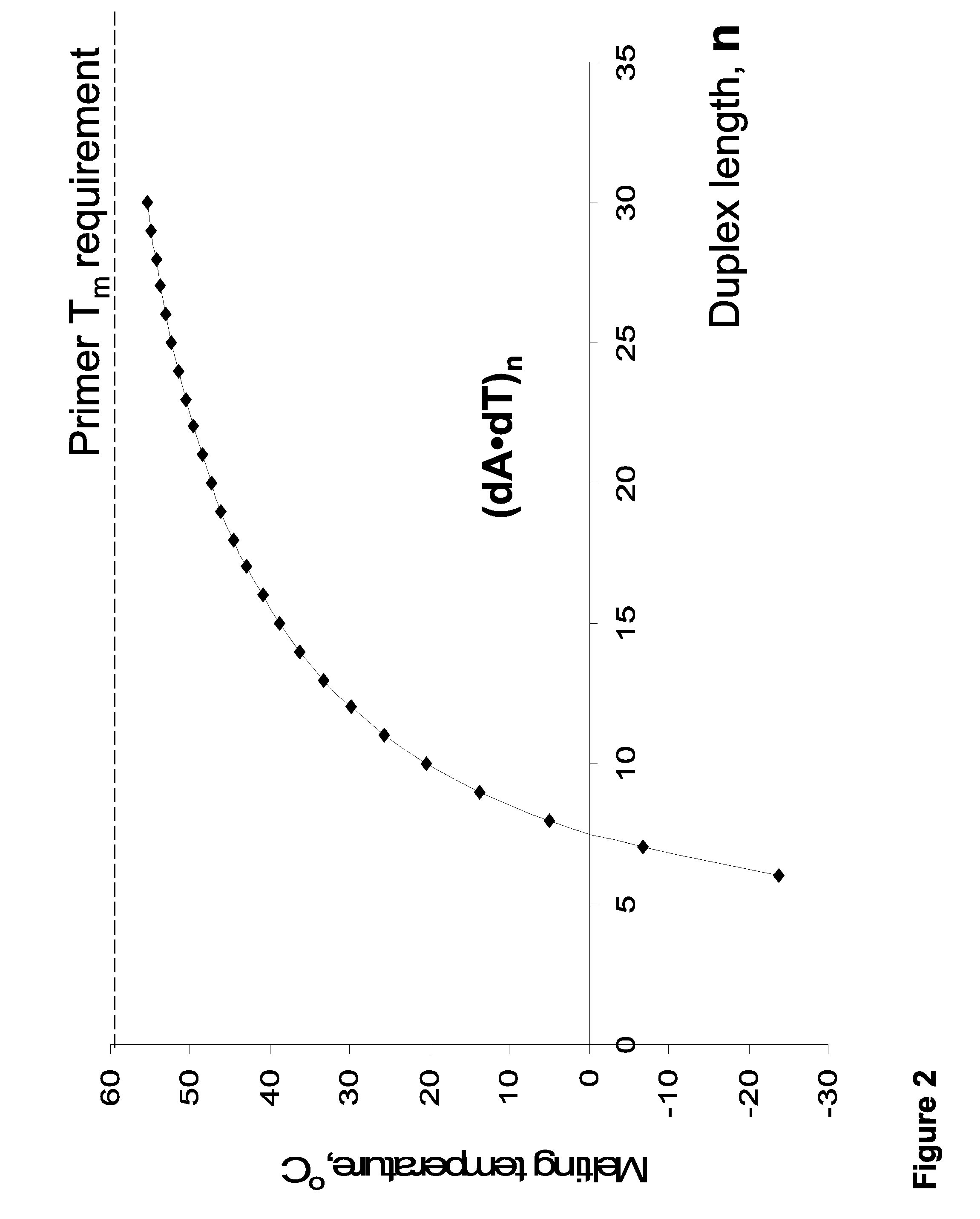However, the sensitivity of such direct detection hybridization assays is limited, and although some
highly sensitive technologies for direct
nucleic acid detection are currently under development, amplification of targeted nucleic acids is an important component of typical
DNA detection systems.
However, such differences in duplex stability between A-T and G-C rich sequences
pose a serious problem for
nucleic acid detection.
Significantly, identification of suitable detection oligonucleotides is often challenging or problematic because of thermodynamic diversity of the target nucleic acids; for example, identification of detection oligonucleotides having sufficient utility at the elevated temperatures characteristic of art-recognized
Polymerase Chain Reaction (PCR) methods (e.g., Mullis K. B. et al, U.S. Pat. No. 4,683,195 and Mullis K. B., U.S. Pat. No. 4,683,202) is often problematic, and in some instances precluded, because of the presence of particular A-T and G-C sequence compositions in the target sequences (e.g., A-T-rich and / or G-C-rich sequences).
Unfortunately, while elevating the temperature for an additional extension stage (>72° C.) enhances this aspect of the PCR reaction, even
short exposure of the reaction to low annealing temperature can trigger “mispriming” and primer-
dimer formation.
Nonetheless, the typical annealing ranges (from ˜56-58 to ˜60-62° C.) persist in view of the structural and thermodynamic diversity of the nucleic acid or DNA per se; that is, A / T-rich duplexes are significantly less stable than duplexes with relatively elevated G / C content, and
reaction conditions utilizing more elevated annealing temperatures would significantly limit the scope of prior art methods.
However, unless the extension extends through a ‘GC island,’ increasing the primer length for analysis within AT-rich sequences does not overcome the associated
thermal stability problem. FIG. 2 illustrates that
thermal stability of (dA-dT)n homopolymers tends to reach a ‘
plateau’ value slightly above 60° C., and increased stabilization efficiency per base (° C. / base) decreases rapidly for oligonucleotides longer than 25-30-mers.
Additionally, extremely AT-rich primers cannot be used for PCR at temperatures>70° C. Moreover, long primers (>30-40-mers) have limited use because of associated low manufacturing yields and quality.
Gene expression studies are among the least likely PCR applications to be associated with problems in
system designs because the
target gene sequences are usually relatively long, providing ample sequence distance for design of suitable primers and a probe.
By contrast, PCR
system designs for detection of polymorphisms (e.g., SNPs) are limited to or restricted by the location of the target polymorphism, and establishing a good
system or detection design is typically difficult, in not impossible when the target polymorphism is located within a thermoliable target region with an AT content exceeding ˜65-70%.
However, the instrument has only 16 PCR reaction compartments and, while exceptional, is consequently not particularly suited for high-
throughput analysis.
For these instruments, therefore, selection of an elevated temperature PCR regime may preclude detection of many targets of interest, narrowing the analytical scope.
For example, where the primers are designed to perform at an annealing temperature of 70° C., the probe Tm must be >75° C., which is a difficult requirement to achieve.
Unfortunately, however,
DNA polymerase (e.g., Taq) does not tolerate many, if not most of the structural modifications potentially applicable in probe designs.
Regardless of the significant progress made up to date in nucleic acids detection, the methods of enhancing the hybridization properties of primers and probes are still not optimal
Manufacturing of modified oligonucleotides carrying duplex-stabilizing moieties and
nucleotide analogs is limited, complex and expensive.
Unfortunately, these base-modified primers have not adopted in the art, most likely because of the relatively high cost of manufacturing.
Chemical synthesis of polynucleotides is inefficient and difficult, and certain structural modifications can not be chemically introduced because of their relative
instability.
However, examples of using modified dNTP derivatives to prepare polynucleotides with enhanced hybridization properties are exceptionally rare.
Therefore, these reported results are inconsistent and inconclusive and do not clarify the art with respect to any general or further applicability of the use of base-modified analogues of
ribonucleoside 5′-triphosphates (rNTPs).
However, these modifications have a negatively effect on DNA hybridization properties (Wang J. X. et al (2005) Nucleosides Nucleotides Nucleic Acids, 24: 951-955) and this makes these borano-modified dNTPs effectively useless in practicing detection PCR.
Gourlain T. et al., (Nucleic Acids Res., 29: 1898-1905, 2001) showed that substrate properties of c7AdTP can be improved via incorporation of pendant aminopropyl, Z-aminopropenyl and aminopropynyl side chains at the C7-position of the heterocyclic system, however, accurate measurements of PCR yield were not done and the utility and applicability of these derivatives to detection PCR has not been established.
However the reported data indicate that application of dITP in PCR is extremely limited and these base-modified
nucleoside triphosphates cannot be used as complete substitution for natural dGTP.
In contract to these rigid linkers, flexible alkyls negatively affect dNTP substrate properties.
Unfortunately, all of the above cited studies did not include accurate comparisons of the modified dNTPs with the substrate properties of the respective natural deoxynucleoside 5′-triphosphates, so the practical utility of these analogs for detection PCR remains ambiguous and uncertain in the art.
In summary therefore, the traditional approaches to duplex stabilization that concentrate on the primer and probe modification are impractical, and the utility of incorporating base analogs during amplification in detection PCR remains ambiguous and uncertain in the art.
 Login to View More
Login to View More 


